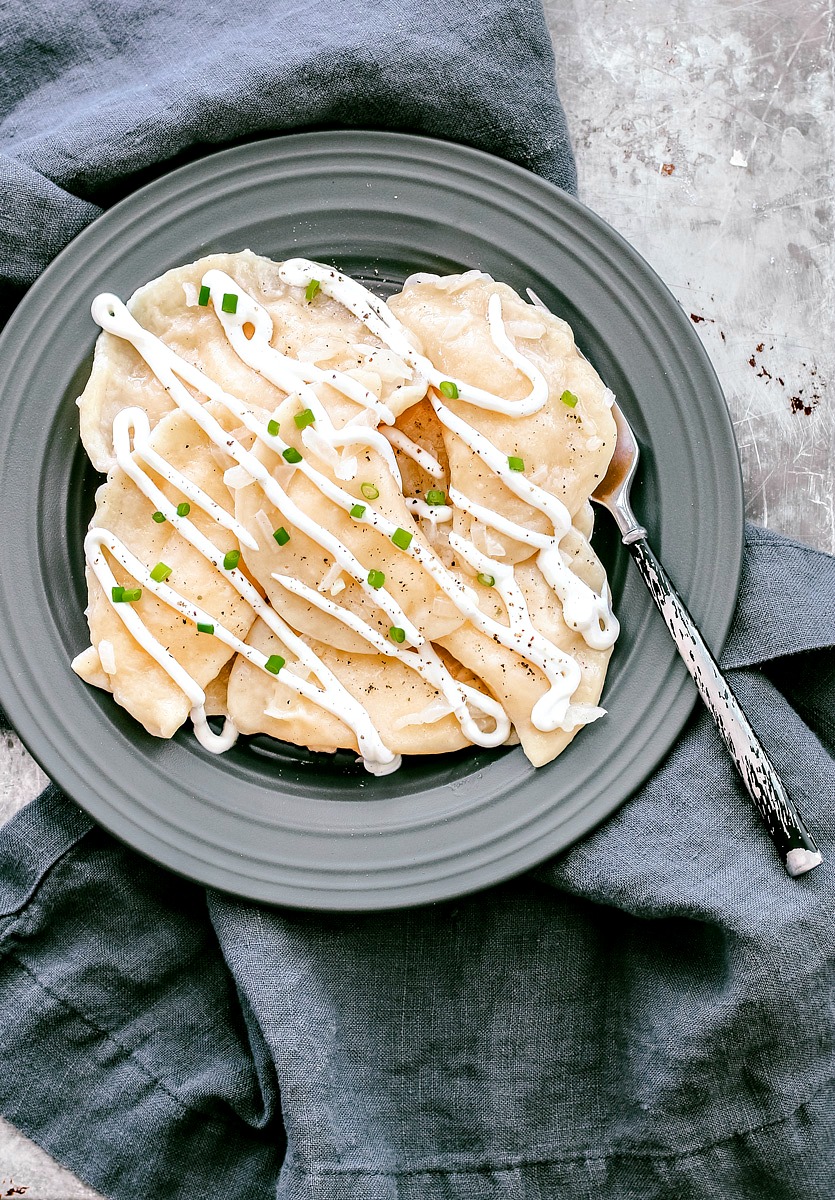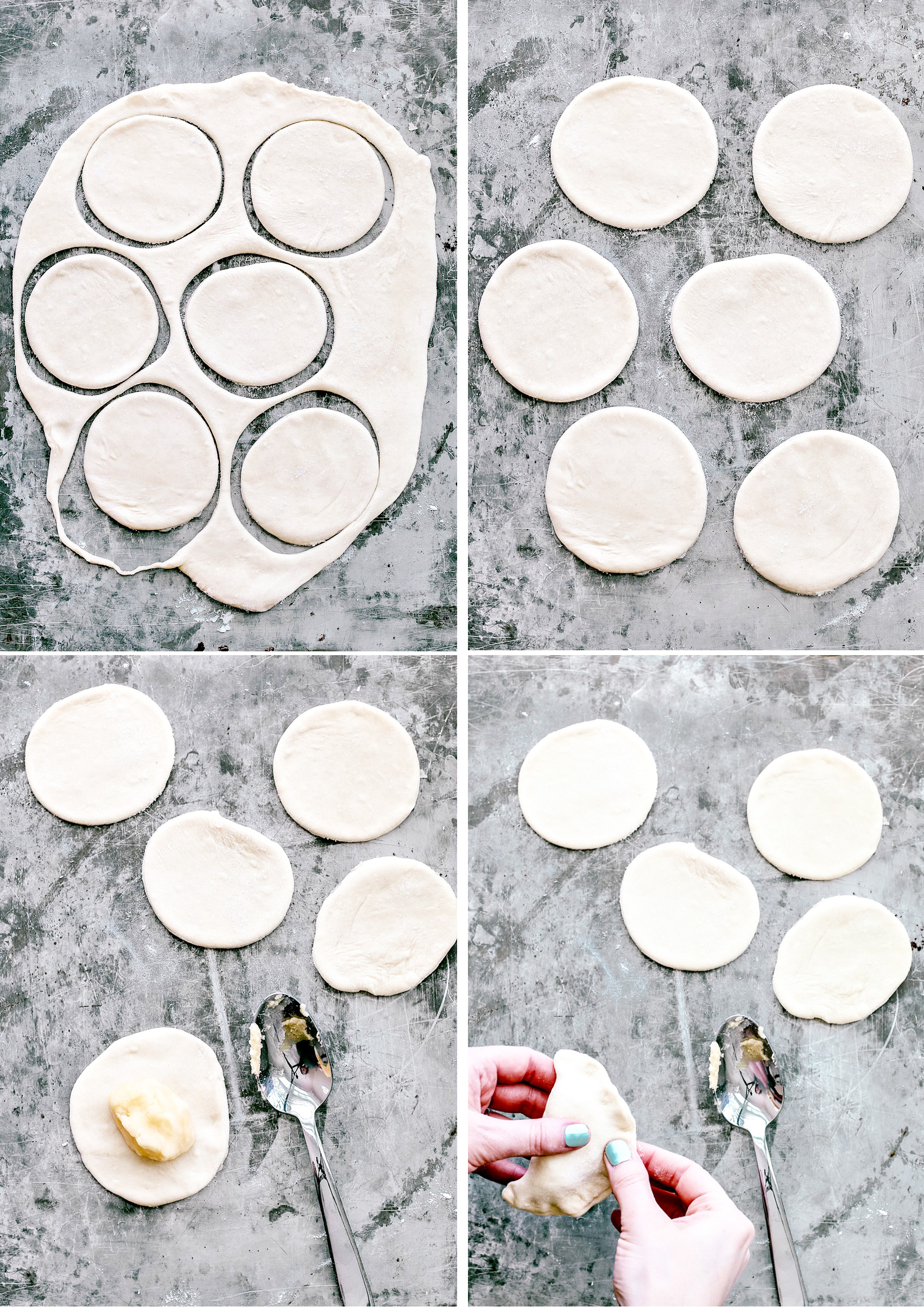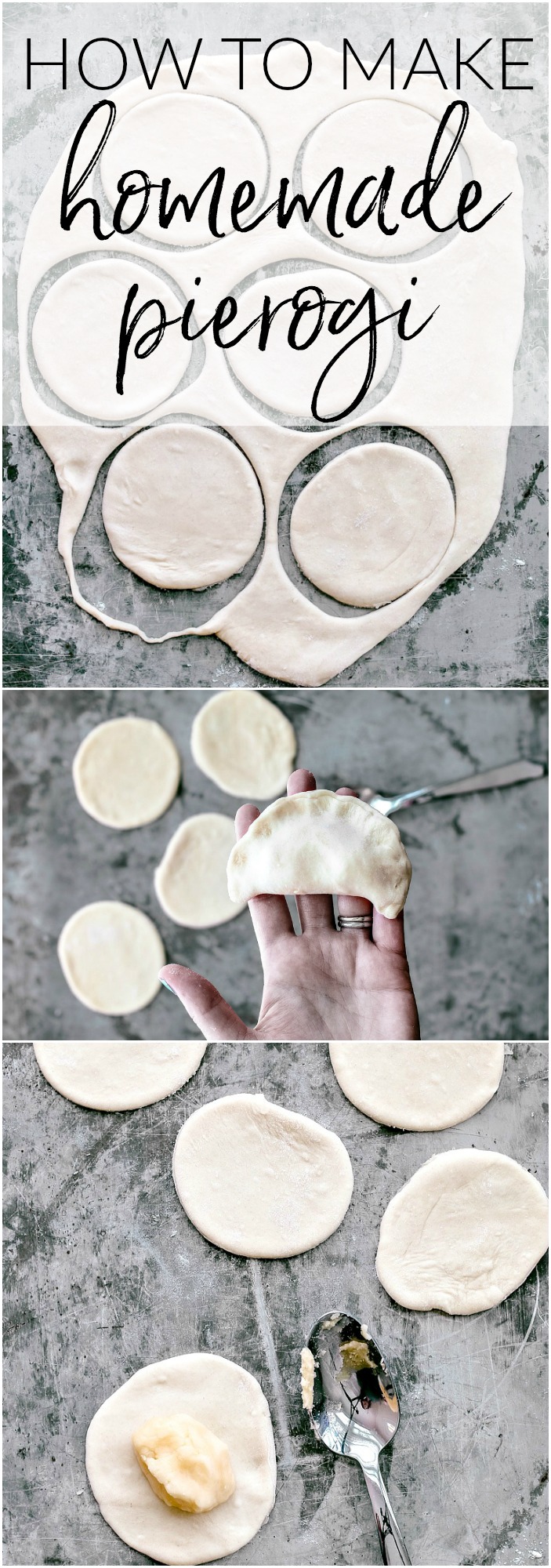This post contains affiliate links. Please see our disclosure policy.
Anyone who grew up with Ukrainian or Polish roots will agree: homemade pierogi are everything.
Those sad potato dumplings found in the freezer section of your supermarket? Not pierogi.
Legit pierogi come from a recipe; a recipe written in fanciful cursive shorthand by your grandmother on an ancient piece of paper you keep promising yourself you won’t lose.
Because losing this recipe is an actual fear of mine, I’ve decided to bring it to the blog and, more importantly, learn it. Learn it like my Ukrainian roots depend on it.
A labor of love.
Making pierogi from scratch isn’t difficult, but it’s a labor of love and it’s definitely something you want to do with one or two other people. I loved spending the afternoon with my grandmother and father making pierogi—carefully stuffing each one and pinching them shut until my little fingers ached. Sure, we could have used those clamps, but to me the pinching was part of the experience and the ruffled edges symbolized care for the craft.
Stuffing the pierogi is easy once you have a knack for it, but it takes a little practice. You don’t want to over-stuff them—as tempting as it may be—and you obviously don’t want to under-stuff them. I aim for a happy medium between a teaspoon and a tablespoon. After a few pierogi, you’ll find what portion works best for the dough circles you’re using.
About that filling…
I like to keep it simple with velvety mashes potatoes, cooked onions, and aged cheddar. I can appreciate sauerkraut pierogi, but please don’t ever come at me with, “Hey, I had a deep-fried pierogi stuffed with blueberries and drizzled with chocolate at a restaurant last week for dessert; I thought you’d be proud!”
No.
To boil or to fry?
People ask me this often, and it’s up to your own preference. When my pierogi are freshly made and boiled, I toss them in buttered onions, top them with an intimidating dollop of sour cream, and go to town. When cooking from frozen, I tend to boil them until they float, then toss them into a frying pan with some butter, onions, and mushrooms if I’m feeling extra. A lot of omnivores enjoy them with fried up with bacon. I don’t eat pork anymore, but I do remember the combination being delicious.
Oh, and if you’re into it, hot sauce! Hot sauce is a *sometimes* thing, since I like my pierogi to be pure in the most Ukrainian of ways, but hey—we all rebel sometimes.
If you make this recipe, please snap a pic and tag me on Instagram @killing__thyme! I love hearing from you <3

Homemade Pierogi
Ingredients
Dough
- 4.5 cups all-purpose flour
- 3/4 cups warm water
- 3/4 cups warm milk
- 3 TBSP melted butter
- 2 egg yolks, lightly beaten
- 1 tsp kosher salt
Potato and cheese filling
- 4-5 large Russet potatoes
- 1/8 cup milk
- 8 oz aged cheddar cheese, shredded
- Kosher salt and cracked black pepper, to taste
Optional garnishes
- Sour cream
- Cooked onions
- Chives
Other
- 1 Large white onion, finely diced
- 3 TBSP butter
- Sour cream
- Chives
Instructions
- In a large bowl, combine the water, milk, butter, and egg yolks; mix until cohesive. Gradually mix in the flour and sea salt until it thickens into a dough-like consistency.
- Flour a clean flat surface, transfer the dough to it, and gently knead it for about two minutes or until it is smooth. The dough should feel somewhat like pizza dough, elastic but not wet. Add a little extra flour if the dough is too moist. Divide the dough into two, shape into a rough ball, and place them both into a lightly oiled bowl. Cover and let rest for at least 30 minutes. You can let it rest overnight if you're trying to get a head start the next day.While the dough rests, you can work on your filling.
Potato and cheese filling
- Bring a large pot of salted water to a boil. Add the potatoes (peeled) and cook for about 15 minutes or until tender and can easily be pierced knife. Drain the potatoes and mash them with a potato masher. Halfway through, add a splash of milk, the cheese, and some salt and pepper, and continue to mash until cheese is blended and potatoes are smooth. Taste, season as needed, and set aside.
Butter and onions
- Melt about 3 TBSP of butter in a medium sauce pan. Add the finely diced onions and cook until softened and translucent, about 5-7 minutes. Transfer to a large bowl or pot and set aside.
Dough
- Transfer one of the dough balls to a clean and lightly floured surface again, and with a rolling pin, roll it out and flatten it.1/8 inch thick. Use a round drinking glass or round cookie cutter, about 3 inches in diameter, to cut out your circles. Set them aside. With the leftover dough, knead it and roll it out, and repeat the cutting process until you have none left. Then do the same with the other ball of dough. (I separate the dough because it's easier to roll out/work with smaller amounts of dough.)
- Plop about 1 heaping teaspoon of potato mixture into the centre of the dough circle. Fold the circle over the potato filling and pinch the ends very tightly to ensure that the dough is sealed.
- As you go, place the finished pierogi on a large clean towel. You can cover them to prevent drying while they sit out.
Cooking the pierogi
- Bring a large pot of salted water to a boil. Place about a dozen pierogi into the water at a time. Stir to prevent sticking. When they're ready, they'll float to the top. Transfer floaters to the pot of buttery onions and toss. Then transfer to freezer bags or storing containers. (The butter keeps them lubricated and prevents sticking; the onions are just there to be delicious.) Repeat until done.
- You can eat these fresh pierogi right away, and freeze what you don't plan to eat within five days. When you want to cook from frozen, simply boil them until they float and give them a quick fry in a pan with some butter and onions; serve with sour cream and chives.









Thank you for sharing these – I love pierogi! A good sauerkraut filled pierogi can’t be beat. Can’t wait to try making some more at home!
Sauerkraut ones really are tasty! Making these bad boys at home is so awesome, and worth the work :)